
views
- Make your bed every morning when you get up.
- Toss dirty clothes right in the hamper when you take them off.
- Tidy up clutter and throw out trash every day.
- Vacuum your bedroom once a week.
Keeping Your Room Clean

Make your bed every morning when you wake up. One of the most effective ways to keep your room clean is by making your bed every day. Make sure the corners on your fitted sheet align with the corners of the bed and tuck the top sheet under the edges of your mattress. Spread your blanket or comforter evenly across the entire bed, then fluff and position your pillows. To make hospital corners on your top sheet, tuck one end in at the end of the bed. Pick up the corner of the sheet and put the edge on the top of the bed, forming a triangle. Tuck the bottom edge of the sheet into the mattress, then pull the triangle down and tuck it into the mattress to form a clean line along the corner of the bed.

Hang up jackets and throw clothes in the hamper when you get home. If you like to change into comfy clothes after a long day at school or work, throw your dirty clothes straight into the hamper. Fold and put away any clean clothes that you're going to wear again. After a long day, it can be tempting to throw your coat and clothes on the floor or bed. However, putting away your clothes as soon as you take them off can help you maintain a clean room. Try to avoid leaving dirty clothes on the floor, on the bed, or lying around in the bathroom or laundry room. Consider placing laundry hampers in areas where you regularly change, like in the bathroom, in your closet, or near your dresser.
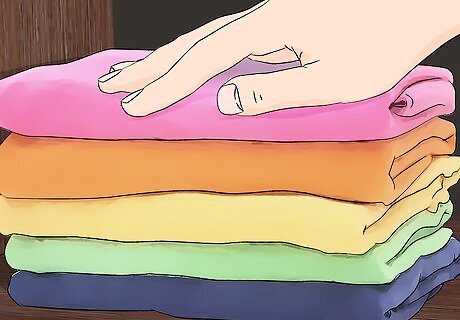
Do your laundry every week and put it away immediately. It can be easy to let the dirty laundry pile up for weeks or leave your clean laundry piled in a basket. However, this can quickly lead to a messy room. When your clothes are out of the dryer, fold them and put them away or hang them in the closet. Try to wash your bed linens (like your pillowcases, blankets, top sheets, and fitted sheets) at least every one to two weeks. Leaving your clean clothes in the dryer or hamper can also cause wrinkles. Try to follow a set schedule when it comes to doing laundry. For example, you might wash and fold your laundry every Saturday or every second Friday.
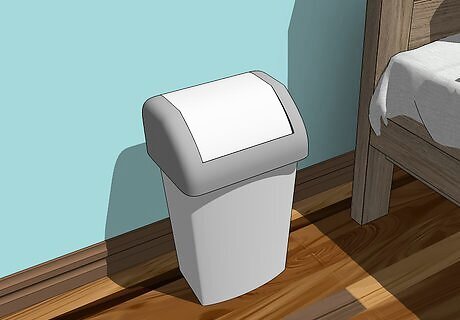
Keep a garbage can and cleaning supplies in your room. Storing supplies like microfiber cloths, disinfecting wipes, and floor cleaners in your room can make it more convenient to keep your room clean. Place a garbage can and a bin full of cleaning supplies somewhere handy, like in your closet, so you can clean your room right away. If you have pets or younger children in the house, place your bin of cleaning supplies in a closet with a door or on a high shelf. As soon as the garbage can is full, put it straight in your collection bin or place it in the garage or shed until collection day. Sanitize your trash can with a household cleaner once a week.

Vacuum, mop, and dust your bedroom every week. Vacuum the floors and baseboards to suck up dirt and dust. If you have hardwood or linoleum floors, use a mop to clean up spills and grime. Use a damp microfiber cloth to dust all the surfaces in your room, including furniture, fixtures, fans, pictures, shelves, and tables. If you have pets or allergies, try to vacuum and dust daily or at least two to three times a week.

Try to avoid eating in your room. Having food in your room can attract bugs, cause spills, leave crumbs all over the place, and lead to a buildup of plates and cups in your room. Instead, try to make your room a food-free zone and do all your eating and snacking in the kitchen. Take plates, cups, utensils, and food waste back to the kitchen immediately if you ever do eat in your room. Try to always use coasters under glasses, cups, and flower pots to prevent water spots and rings on wooden surfaces.
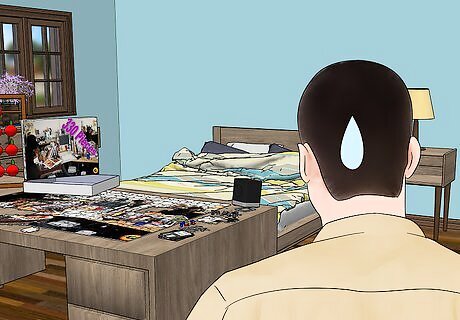
Make a list of daily chores and try to stick to it. Keeping your room clean is all about getting into a good routine. Ignoring your cleaning duties for just a few days can create an overwhelming list of chores. Make a list of daily chores and post it somewhere visible in your bedroom. Set aside about 10 to 15 minutes every day to address these cleaning tasks. Daily chores might include making the bed, putting away dirty clothes, or tidying up toys, papers, and other items. If you miss a day of cleaning, try to do those chores as soon as you can the next day to prevent messes from building up. Try turning cleaning into a game to make the job more fun. Challenge yourself to clean your room as fast as possible and try to beat your previous time.
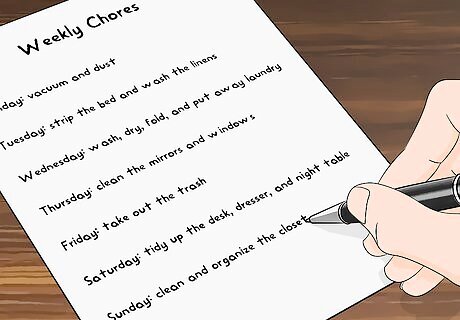
Create a schedule for weekly chores like taking out the trash. Make a list of chores that you should do every week, like vacuuming or dusting, and make a schedule where you tackle a different weekly cleaning task each day of the week. This can help keep your room clean and make your chores feel more manageable. Here's a sample list: Monday: Vacuum and dust. Tuesday: Strip the bed and wash the linens. Wednesday: Wash, dry, fold, and put away laundry. Thursday: Clean the mirrors and windows. Friday: Take out the trash. Saturday: Tidy up the desk, dresser, and night table. Sunday: Clean and organize the closet.
Deep Cleaning Your Room

Remove any clothes and clutter from your room. Clearing clutter from your bedroom can make deep cleaning easier—plus, seeing those tidy surfaces can help boost your motivation. Put dirty clothes into the hamper, fold and put away clean clothes, and put items like books, paperwork, and office supplies in their designated spots. Start by decluttering the floor, then move to your dresser, desk, nightstand, and other surfaces. Professional organizer Christel Ferguson says that “your nightstand should be [completely] cleared off.” Collect cups, utensils, mugs, food storage containers, and other items that belong in the kitchen and take them downstairs to the sink or dishwasher. Put away any food packets or cans.Tip: Don’t forget to look under the bed, on the closet floor, and on top of furniture when you're collecting.
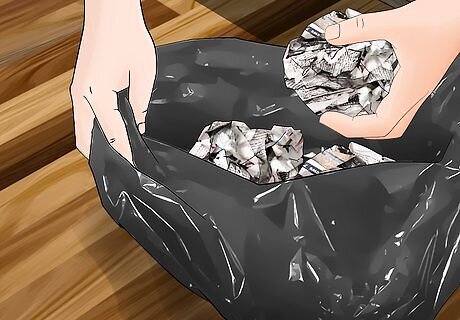
Collect and take out the garbage. Go around the room with a trash bag and pick up wrappers, food, old papers, and any other trash you find around the room. When you’ve collected all the garbage, empty your bedroom garbage bin into the trash bag and take the bag down to wait for collection day.

Donate or throw away items you don’t use anymore. One of the biggest contributors to a messy room is having too much stuff. To prevent this, look at your clothes, toys, accessories, and other items. Make five piles: one pile for items you’d like to keep, one for items you use seasonally or rarely, one for trash, one for recycling, and one for donation. If you haven't used or worn something in over a year, there's a good chance you can donate it without missing it. Keep a trash bag for things you’d like to throw away. Throw things out if they're broken, have holes, or can't be reused or recycled. Professional organizer Christel Ferguson recommends putting items that you use seasonally, like heavy blankets and winter clothes, in the garage or attic for long-term storage.
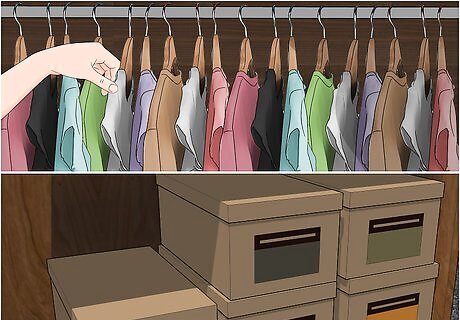
Hang up your clothes and organize items in your closet. Closets can be a place where you throw everything that you don’t want to deal with right away—now it’s time to address it. Take all your items out and place them on your floor or bed. Tidy up your shoes, hang up clothes, and throw away any garbage. To keep your closet organized: Make it a routine: Go through your closet once or twice per year, and clear out the items you no longer use. Use wasted wall space: Make blank wall space functional by installing shelves or hooks to hang accessories. Raise your clothes rod: Open up some space by hanging your clothing rod higher on the wall. This can allow you to put a dresser or shoe rack underneath your hanging clothes. Place items you use frequently in front: Put the items that you reach for first in the most accessible parts of your closet. This can help you get ready faster. Get slimmer hangers: To save space, professional organizer Christel Ferguson recommends using thin hangers instead of wooden hangers, which can “take up a lot of space.”

Strip your bed, wash the linens, and make your bed with fresh sheets. Grab a fresh set of linens for your bed or wait until yours are washed and dried. Pull a fitted sheet over the mattress first, followed by the top sheet and any blankets you regularly use. Put the pillow cases back on the pillows next, then place the pillows on the bed. While your sheets are off your bed, vacuum your mattress with the upholstery attachment. To remove odors, sprinkle baking soda, let it sit for 30 minutes, then vacuum it up. If you have an upholstered bed frame, use a vacuum with an upholstery attachment to remove the dust and debris that gets stuck on it. If you can do a load of laundry on your own, wash your linens in the washing machine using your regular cycle. Otherwise, leave the linens for an adult to wash.
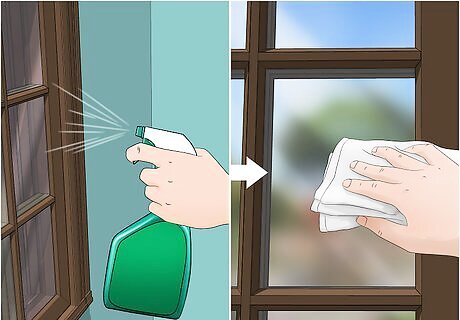
Clean windows and mirrors with a glass cleaner and microfiber cloth. Spray the mirror with window cleaner, or with a solution of one part vinegar and one part water. Use a clean microfiber cloth or paper towels to wipe the mirror dry. Repeat with all the windows, picture frames, and mirrors in your bedroom. Vacuum your window sills and blinds or shades with a brush attachment to remove any dust. If you have curtains, throw them in the dryer for a few minutes while you wipe down your curtain rods. The dryer can remove dust and de-wrinkle your curtains. Then, hang them back up.

Remove dust from the ceiling, walls, and other surfaces. Use a duster or damp microfiber cloth to dust corners and wall joints, the ceiling fan, light fixtures, shelves, where the wall and ceiling meet, and all the surfaces in your room. As you dust, pick up objects that are obstructing your work, such as a lamp on the dresser, and dust underneath them.
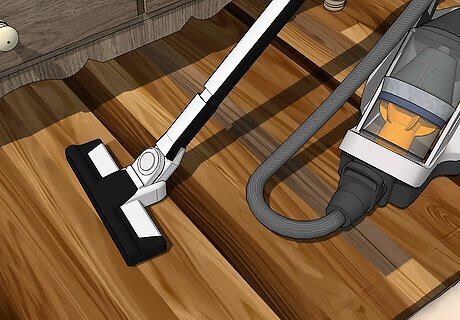
Vacuum or sweep the floor and mop or use a carpet cleaner on stains. Use a vacuum to suck up dirt and dust from any carpets or area rugs in your room. Use a broom to clean up a tiled or wood floor. Use a steam cleaner with water and special carpet cleaner to clean up any large stains. Use special attachments on the vacuum to clean cobwebs from the ceilings, the corners where the floor and wall meet, the baseboards, and other cracks and crevices. Move furniture so you can clean under and behind the bed, dresser, and desk. Try to deep clean your room at least once a month. EXPERT TIP Filip Boksa Filip Boksa House Cleaning Professional Filip Boksa is a House Cleaning Professional and the CEO and Founder of King of Maids, a company based in Chicago, Illinois. With over 10 years of professional experience, Filip and his team at King Maids specialize in providing home cleaning and organization services to their clients. They are dedicated to delivering high-quality and reliable service to ensure customer satisfaction. Filip Boksa Filip Boksa House Cleaning Professional The secret of deep cleaning is attention to detail, not the products you use. Start a deep cleaning in one part of the room and work your way around clockwise from top to bottom. Pick up clothes and clutter, remove the trash, change the linens, and dust everything. Don't forget to wipe down the doors, baseboards, and decor. Finish by cleaning the floors and don't miss under the bed.
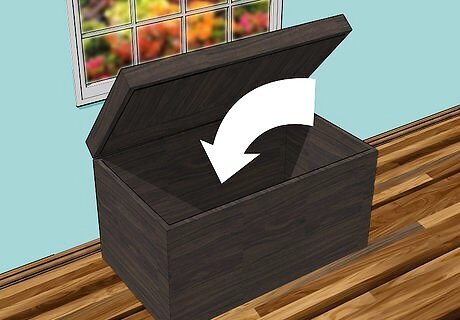
Tackle one area at a time and find a place for everything. When you have stuff that you don’t have a place for, you might collect piles in a specific area or leave things lying around. Make sure you have a hamper for dirty laundry, use a file folder or a file cabinet to organize paperwork, and return books to a designated bookshelf. Think about areas you want to keep clear, like your floor or your desk, and how you can use your existing drawers or closet space to organize the items there. Use baskets or other storage containers to keep extra stuff organized if you don’t have a spot for it. Place these in your closet or on a shelf where you can easily access them. Once everything has a designated space, try to return items to the place they belong as soon as you’re done with them.



















Comments
0 comment